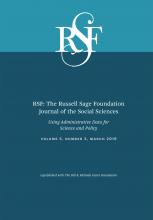Research Article
Open Access
Subprime Babies: The Foreclosure Crisis and Initial Health Endowments
Janelle Downing, Tim Bruckner
RSF: The Russell Sage Foundation Journal of the Social Sciences March 2019, 5 (2) 123-140; DOI: https://doi.org/10.7758/RSF.2019.5.2.07
Janelle Downing
a Assistant professor in the OHSU-PSU School of Public Health
Tim Bruckner
b Associate professor of public health at the University of California, Irvine

REFERENCES
- ↵
- Alexander, Greg R.,
- John H. Himes,
- Rajni B. Kaufman,
- Joanne Mor, and
- Michael Kogan
- ↵
- ↵
- ↵
- Barfield, Wanda D.,
- Karen M. Clements,
- Kimberly G. Lee,
- Milton Kotelchuck,
- Nancy Wilber, and
- Paul H. Wise
- ↵
- ↵
- Black, Sandra E.,
- Paul J. Devereux, and
- Kjell G. Salvanes
- ↵
- Bocian, Debbie Gruenstein,
- Wei Li,
- Carolina Reid, and
- Roberto G. Quercia
- ↵
- Bradbury, Katharine,
- Mary A. Burke, and
- Robert K. Triest
- ↵
- Bruckner, Tim A
- ↵
- ↵
- ↵
- Buescher, Paul A.,
- Karen P. Taylor,
- Mary H. Davis, and
- J. Michael Bowling
- ↵
- Catalano, Ralph A., and
- Tim Bruckner
- ↵
- Catalano, Ralph A.,
- Sidra Goldman-Mellor,
- Katherine Saxton,
- Claire Margerison-Zilko,
- Meenakshi Subbaraman,
- Kaja LeWinn, and
- Elizabeth Anderson
- ↵
- CoreLogic
- ↵
- Coulton, Claudia J.,
- Francisca Richter,
- Seok-Joo Kim,
- Robert Fischer, and
- Youngmin Cho
- ↵
- Currie, Janet, and
- Enrico Moretti
- ↵
- ↵
- Delnord, Marie,
- Katarzyna Szamotulska,
- A. D. Hindori-Mohangoo,
- Béatrice Blondel,
- A. J. Macfarlane,
- Nirupa Dattani,
- Carmen Barona,
- Sylvie Berrut,
- Irisa Zile,
- Rachel H. Wood
- . Luule Sakkeus,
- Mika Gissler, and
- Jennifer Zeitlin
- ↵
- ↵
- Downing, Janelle,
- Andrew Karter,
- Hector Rodriguez,
- William H. Dow,
- Nancy Adler,
- Dean Schillinger,
- Margaret Warton, and
- Barbara Laraia
- ↵
- Downing, Janelle,
- Barbara Laraia,
- Hector Rodriguez,
- William H. Dow,
- Nancy Adler,
- Dean Schillinger,
- E. Margaret Warton, and
- Andrew J. Karter
- ↵
- Duca, John V
- ↵
- Ellen, Ingrid Gould,
- Johanna Lacoe, and
- Claudia Ayanna Sharygin
- ↵
- Feldman, Pamela J.,
- Christine Dunkel-Schetter,
- Curt A. Sandman, and
- Pathik D. Wadhwa
- ↵
- Financial Crisis Inquiry Commission
- ↵
- Flood, Sarah,
- Miriam King,
- Steven Ruggles, and
- J. Robert Warren
- ↵
- Foote, Christopher L.,
- Kristopher S. Gerardi, and
- Paul S. Willen
- ↵
- Fukuda, Misao,
- Kyomi Fukuda,
- Takashi Shimizu, and
- Henrik Møller
- ↵
- Gliklich, Richard E.,
- Nancy A. Dreyer, and
- Michelle B. Leavy
- ↵
- ↵
- Hack, Maureen,
- Nancy K. Klein, and
- H. Gerry Taylor
- ↵
- Hall, Eric S.,
- Neera K. Goyal,
- Robert T. Ammerman,
- Megan M. Miller,
- David E. Jones,
- Jodie A. Short, and
- Judith B. Van Ginkel
- ↵
- ↵
- ↵
- Hansen, Dorthe,
- Henrik Møller, and
- Jørn Olsen
- ↵
- Harris-Kojetin, Brian A., and
- Robert M. Groves
- ↵
- Herrchen, Beate,
- Jeffrey B. Gould, and
- Thomas S. Nesbitt
- ↵
- Hobel, Calvin J.,
- Amy Goldstein, and
- Emily S. Barrett
- ↵
- Hogue, Carol J. R.,
- Corette B. Parker,
- Marian Willinger,
- Jeff R. Temple,
- Carla M. Bann,
- Robert M. Silver,
- Donald J. Dudley,
- Matthew A. Koch,
- Donald R. Coustan, and
- Barbara J. Stoll
- ↵
- Kaufman, Jay S
- ↵
- Kesmodel, Ulrik S
- ↵
- Kramer, Michael R.,
- Anne L. Dunlop, and
- Carol J. R. Hogue
- ↵
- Kramer, Michael S.,
- Lise Goulet,
- John Lydon,
- Louise Seguin,
- Helen McNamara,
- Clement Dassa,
- Robert W. Platt,
- Moy Fong Chen,
- Henriette Gauthier,
- Jacques Genest,
- Susan R. Kahn,
- Michael Libman,
- Rima Rozen,
- André Masse,
- Louise Milner,
- Guylaine Asselin,
- Alice Benjamin,
- Julia Klein,
- Gideon Koren
- ↵
- Krivo, Lauren J., and
- Robert L. Kaufman
- ↵
- ↵
- Margerison-Zilko, Claire E.,
- Ralph Catalano,
- Alan Hubbard, and
- Jennifer Ahern
- Margerison-Zilko, Claire E.,
- Yu Li, and
- Zhehui Luo
- ↵
- ↵
- Martin, Joyce A.,
- Brady E. Hamilton,
- M. J. Osterman,
- Anne K. Driscoll, and
- T. J. Mathews
- ↵
- Mullainathan, Sendhil, and
- Eldar Shafir
- ↵
- Oken, Emily,
- Ken P. Kleinman,
- Janet Rich-Edwards, and
- Matthew W. Gillman
- ↵
- ↵
- Pedersen, Carsten Bøcker
- ↵
- ↵
- Putnam-Hornstein, Emily,
- Julie A. Cederbaum,
- Bryn King, and
- Barbara Needell
- ↵
- Reid, Carolina K.,
- Debbie Bocian,
- Wei Li, and
- Roberto G. Quercia
- ↵
- Reid, Carolina K., and
- Elizabeth Laderman
- ↵
- ↵
- Rugh, Jacob S., and
- Douglas S. Massey
- ↵
- Schoendorf, Kenneth C., and
- Amy M. Branum
- ↵
- Strauss, Richard S
- ↵
- Wasi, Nada, and
- Aaron Flaaen
In this issue
Subprime Babies: The Foreclosure Crisis and Initial Health Endowments
Janelle Downing, Tim Bruckner
RSF: The Russell Sage Foundation Journal of the Social Sciences Mar 2019, 5 (2) 123-140; DOI: 10.7758/RSF.2019.5.2.07
Jump to section
Related Articles
- No related articles found.
Cited By...
- No citing articles found.





